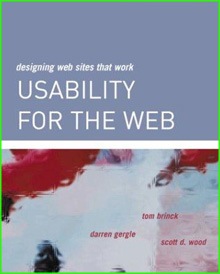Usability for the Web - designing websites that work

The core principle discussed in the book is how to integrate usability principles into everything, thereby putting the user at the centre of the initial design stage.
Buy the book from Amazon and save money!
This review was published in CM Focus in January 2003.
From the title - Usability for the Web - it would appear that this is just another book telling you what to design. How wrong! This is more about how to design user-friendly websites that really work for the end user. There are plenty of ideas and advice on design principles, but what makes this book stand out is that this is presented in the context of an overall process and set of methods.
The structure is as you would expect: what is meant by 'usability'; the design process; targeting an audience and understanding the IT set-up they use; mockups; production; launch; and finally, evaluation.
The core principle discussed in the book is how to integrate usability principles into everything, thereby putting the user at the centre of the initial design stage. It sounds like a cliché - but how many people really achieve this?
The design process the book promotes is based on common sense, seen in many other publications that most people follow intuitively. But the difference here is that the usability principles are better understood because it is put in the context of an overall process and employs examples from current websites.
For me, there were two sections that stood out. The chapter on defining an audience examines how much people vary and the different types of computers and software they use. It suggests thinking of the various scenarios under which a user will access and use a site so that an understanding of what they want to experience can be built into the design. It's very easy to overlook people with a disability, or users from other countries where symbols, for example, may mean something totally different.
The chapter on design elements is also well written. It looks at the details and imagery contained within each web page. Many useful tips and advice are given on graphic design, colour, typography, icon and form design. All of this is illustrated with plenty of examples from various websites.
I also agree with the comment made by David Rogers, who reviews the book on Amazon: "The value of Usability for the Web is how it puts all the pieces together in a very coherent way.” To complement this, the book features the added benefit of a website where the various forms it recommends can be downloaded as pdf's.
I did like the various examples of forms and check-lists. Each would need to be adapted to individual circumstance, but they are a very useful starting point.
The authors of this book, between them, have quality industry experience in website design, usability, human-computer interaction and user interface. This gives the book great credibility, which is obvious from the practical advice given. The book is American, but don't let that put you off. It is refreshingly well written in plain English without the usual American phraseology.
Having described all of the things I liked about this book, I felt that it tried to cater for too many different people. For example, the authors claim that managers would find this book useful. In my opinion, it should have targeted web developers, designers and usability specialists and then covered some of the sections in even greater depth. I believe that this would have been particularly useful.
This scattergun approach to the book's target audience is that some topics are not covered particularly well. For example, the sections on project management and writing for the web really do need more depth and greater treatment than given here.
Another let down was that almost all the websites used as examples have changed since the publication. Perhaps they have already read the book!
In summary, this is a good read, written in simple English, and should be kept near the top of a reference list. Many people will find a mass of ideas on how to improve the way they approach designing a website and how to enhance current work. Which reminds me, I had better re-visit the design of my website before the next edition of this book is written.
To buy the book
Buy the book directly from Amazon and save money!
Title:
Usability for the Web: Designing Web Sites that Work
Author:
Tom Brink, Darren Gergle and Scott Wood
Publisher:
Morgan Kaufmann
Released:
October 2001
ISBN:
978-1-558-60658-6

